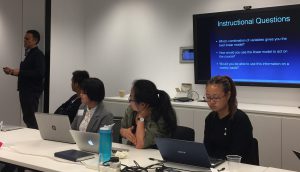As part of the Innovation Week, the University of Sydney held a workshop on how to better use data to understand learners and provide learner support. The hands-on session provided the opportunity to explore which learner support actions can be derived using data in realistic scenarios.

Technology mediates an increasing number of learning experiences. The Learning Management System (LMS) is one of many possible platforms that students use while participating in a learning experience. A unit may use other platforms for discussions, questions, exercises, simulations, animations, and all in different systems. These platforms typically collect detailed information about student interactions. Instructors may use this data to gain insight on student participation and deploy support actions such as personalised feedback.
There are however various hurdles to overcome. One of them is to make sure data is accessible through frictionless processes. Instructors will not use data if sophisticated procedures are needed to access or merge these with other sources. Furthermore, instructors need to think what actions are possible once data is available for exploration and analysis.
Learner Support
The workshop proposed support actions in two categories: those deployed in the near future (in a few weeks, or in the next offering of the unit), and those deployed immediately. Actions deployed in the near future may include suggestions for future units, or rethinking the instructional design for the next offering of the unit. Immediate actions, on the other hand, are deployed while the unit is being delivered. They may include personalised feedback messages to students, suggestions of specific guidelines or resources available through the LMS, or notifications sent to other institutional units. The most important aspect is that they occur while the unit is taking place and they are personalised: combining the data with the expertise of the instructors.
For example, in a unit in which students engage with some resources before attending a tutorial or lab session, the instructors may use the data to detect the level of engagement and send a personalised message suggesting actions to make sure students are properly prepared for the session. Or, if the cohort has students from different programs, they may receive differentiated sets of additional resources for further exploration. Instructors will provide the most adequate feedback if they know, in more detail, the context of every student. Technology can help to scale the process to large student cohorts, so that there is a large potential for impact.
Conclusions
At the end of the workshop attendees presented their ideas for learner support based on the analysis of the provided data. The examples highlighted two important ideas:
- The widespread availability of data changes the type of support actions that are feasible for instructors.
- These actions need to be situated within the context of the a unit’s instructional design for them to be more effective.
Users explored these new spaces and pointed to the next steps to take in their everyday teaching and learning activities.
Where to from here?
- Read more about tools that help teachers make the most of data to help students
- Check out this Teaching@Sydney post about personalising learning support using the SRES
- Read about a current Office of Learning and Teaching project about providing personalised learning support actions





